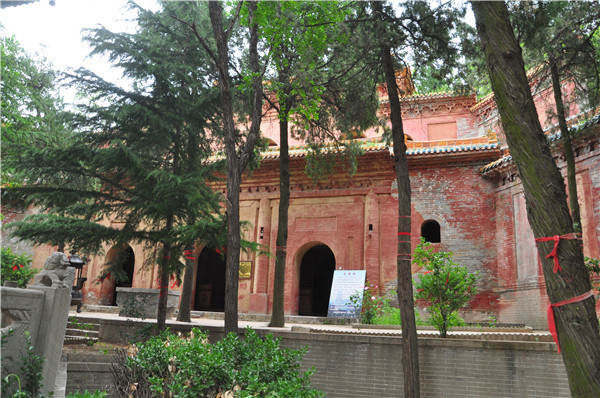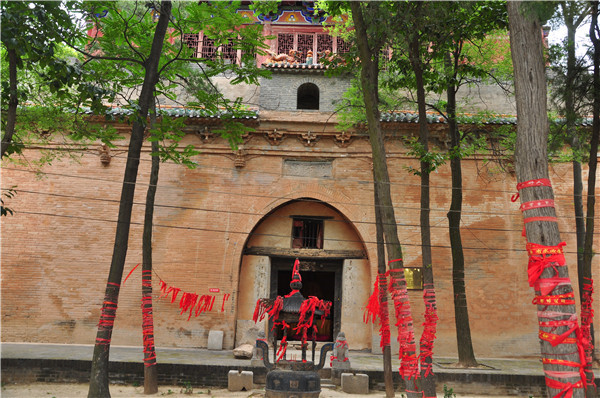
Wangu Temple is located in 300 meters south of Ziran Villiage, Shengli Zhuang, Guxin Zhuang in Puzhou Town, Yongji City. Facing west with the back to the east, it was built close to the mountain, with the length of 200 meters from east to west, and width of 100 meters from north to south. It indeed covers an area of 20,000 square meters. According to the tablet records, the temple was initially founded in the 3rd year of Zhengguang in Northern Wei Dynasty (522). Then, it was rebuilt in the 8th year of Dazhong in the Tang Dynasty (854), which became a famous temple among Hedong region in the Song Dynasty. In Ming Dynasty, this temple was rebuilt many times in Hongwu and Tianshun years. Unfortunately, it was destroyed by an earthquake in the thirty-fourth year of Jiajing (1555) in the Ming Dynasty. During the Wanli period (1573-1620), it was reconstructed and became the present pattern, which was called "The First Buddhist Temple in Zhongtiao". It was partially repaired in 1997, 2000, 2001, 2004 and 2007. From the original central axis from west to east, there were Bell Tower, Drum Tower, Daxiong Hall, Medicine Master Cave, Water and Land Hall, Duobao Buddha Pagoda, Wuliang Hall, Sutra Depository Pavilion, etc. As for its south side, there originally existed Wangu Bieyuan Courtyard, East and West monasteries, Luohan Hall. Currently, there are only Medicine Master Cave, Duobao Buddha Pagoda and Wu Liang Hall, since the rest has already into the ruins. The original gate was built to the east of the central axis, but now it has been transformed into the hall of the heavenly king. There are 21 stele inscriptions of Song, Jin, Yuan, Ming and Qing dynasties in the temple, as well as 4 stone inscriptions of water and land in Piluge. On May 24, 1965, the site was announced as a provincial cultural relic protection unit by the Shanxi Provincial Government.

The temple was grand and magnificent, but the pagoda courtyard of Wangu Temple was deserted due to the disrepair, and the Medicine Master Cave and Wuliang Temple were in tatters and badly damaged. In October 1996, in order to strengthen the protection of cultural relics, the Provincial Cultural Heritage Bureau approved and agreed with Jin Wen Wu Letter (1996) No. 56 document, to take Wangui Temple as the pilot project for the reform of provincial cultural relics management and operation mechanism. At the same time, the government decided to set up the Wangui Cultural Relics Management Institute to be responsible for the maintenance and management of Wangui Temple. Through the efforts in recent years, Wanguu Temple has repaired various sites including the Medicine Master Cave, Wuliang Hall, Pagoda Courtyard and Dubao Buddha Pagoda, Guanyin Hall, Water and Land Hall, Bell Tower, Drum Tower and Mountain Gate. Meanwhile, it also carried out large-scale greening, beautification, hardening, the new construction of a 2000 meters long and 10 meters wide sand and stone tourism road, as well as the expansion of the front door to the back door mountain road nearly a kilometer. The number of tourists is increasing year by year, especially at the annual "traditional prayer temple fair", it is more crowded with people. In 2015, our bureau won the special rescue fund of 500,000 yuan from the provincial bureau, which was used for the emergency reinforcement of Wuliang Temple and Medicine Master Cave. The design plan was approved in June, while the tendering was completed by the end of August and the project started in October. At present, the project has been completed for completion and acceptance.

